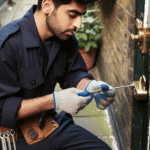Home maintenance often involves tasks that affect your family’s safety, comfort, and daily routine. When issues arise, deciding whether to tackle them yourself or hire a specialist can save time, reduce stress, and ensure the job is done right. Below, we explore common household problems, explain when a DIY approach works, and highlight scenarios where professional help is essential.
Roof Issues
Minor shingle damage, small leaks, or loose flashing can often be repaired safely with a sturdy ladder, basic tools, and favorable weather. Sealing gaps and replacing a few shingles early can extend your roof’s lifespan and prevent water damage. If you lack the equipment or expertise, scheduling roof repair in Los Angeles (or your nearest city) with a qualified contractor ensures the job meets local weather and code requirements. However, signs of underlying structural problems such as sagging areas, extensive mold growth, or water stains on the ceiling always call for expert intervention. A professional assessment uses proper safety gear, advanced sealing techniques, and a full structural inspection to identify weak points and prevent costly damage to wood framing and insulation.
Wall Cracks and Surface Flaws
Hairline cracks near windows or along ceilings are usually the result of normal settling. These can be filled with patching compound and repainted after sanding. This straightforward fix works best when surfaces remain dry, solid, and easily accessible. Wider cracks, recurring gaps, or paint discoloration often point to plumbing leaks, hidden mold, or foundation movement. Professionals use moisture meters, structural scans, and specialized repairs to correct the root cause and prevent the issue from returning. Any wall damage that indicates movement or moisture behind the surface should be evaluated by a qualified contractor.
Plumbing Blockages and Water Leaks
Clogged drains in sinks or tubs can often be cleared with a plunger, drain snake, or enzyme-based cleaner, while a dripping faucet usually responds to a simple washer replacement or tightening. These DIY methods keep minor blockages and leaks under control. On the other hand, symptoms such as gurgling noises in walls, low water pressure in multiple fixtures, or unexplained puddles under floors may reveal burst pipes or underground leaks. Licensed plumbers can locate hidden breaks, test system pressure, and repair pipe joints with professional-grade sealants. Swift action in these cases protects flooring, prevents mold growth, and preserves structural integrity.
Electrical Faults and Fixture Problems
Loose outlets, flickering lights, or a single malfunctioning switch can often be addressed by turning off the power at the breaker panel, replacing a switch or outlet, and testing with a voltage detector. Simple repairs and upgrades such as installing new faceplates or swapping out a damaged light fixture are within reach for homeowners comfortable with basic wiring. However, frequent breaker trips, sparking wires, or a burning odor signal overloaded circuits or serious fire risks. Electricians carry the right tools and qualifications to inspect panels, replace outdated breakers, and ensure your wiring meets current safety codes. Any electrical issue that poses a shock or fire hazard should be left to a professional.
Appliance Trouble and HVAC Failure
Routine maintenance such as cleaning or replacing filters, clearing vent covers, and checking hose connections keeps refrigerators, washers, and HVAC units running efficiently. Many small appliance issues, like a broken control knob or a jammed door seal, can be resolved using manufacturer instructions and common hand tools. Yet loud grinding noises, smoke, or water leaks under appliances indicate internal failures that require a trained technician. HVAC specialists and appliance repair professionals have brand-specific equipment and replacement parts to diagnose motor problems, test electrical components, and restore proper function. Because these systems involve water, refrigerant, and high-voltage power, it’s safer and more cost-effective to call an expert at the first sign of serious malfunction.
Conclusion
Knowing when to DIY and when to call a professional helps you tackle home repairs efficiently while safeguarding your property and loved ones. Small, well-defined tasks under safe conditions—like fixing a running toilet or patching minor drywall cracks—are ideal for a confident homeowner. Larger problems, hidden damage, or any task involving structural integrity, electricity, or extensive water exposure require licensed expertise and specialized tools. By matching each problem with the right solution, you maintain a comfortable, secure, and resilient home.






